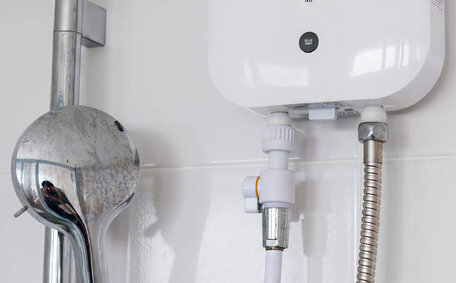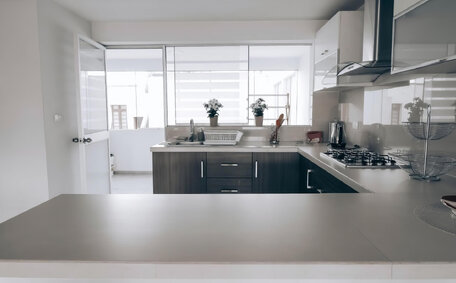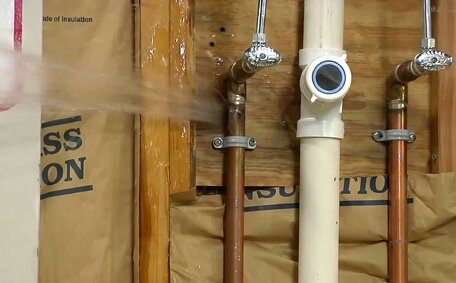What Causes Brown Water from Hot Water Taps
Brown hot water can be caused by multiple factors:
- Sediment build up inside your hot water system, water heater, or pipes. Mineral deposits and rust can accumulate over time, leading to dirty brown water issues.
- Deteriorating old iron pipes and corrosion can initiate water quality issues. Galvanised steel or iron pipes can deteriorate and leach substances into the water, resulting in rusty discolouration at your taps.
- Disruptions or quality issues with your municipal water supply. Disturbances in the water mains can stir up sediment, potentially affecting the water quality in your home.
- Failure in water heaters. Internal corrosion and accumulation of sediment can result in discolored water.
Brown water from your faucet usually indicates problems with your plumbing system rather than your external water source. Identifying the exact cause is essential to develop long-term solutions and ensure your taps deliver uncontaminated, clear water.
Sediment Buildup in Your Hot Water System
Sediment accumulation in your hot water system and heater often results in brown water in both hot and cold taps.
Water can become less clear from your tanks over time as minerals like calcium, magnesium, and silica build up, particularly if it starts running brown. Does my water heater’s sacrificial anode rod contribute to the issue? The anode rod, designed to prevent rust, can deteriorate and contribute to discoloured water when it breaks down.
Minerals accumulate gradually as hot water dissolves deposits while heating and circulating.
Iron, manganese, and calcium are not typically harmful in small quantities but can cause staining and reduce water flow. Thick sediment deposits left unchecked can damage the water heater by overheating elements and causing corrosion.
Flushing your water heater and pipes annually can prevent excessive sediment accumulation, thus improving water quality.
This involves completely draining the tank, removing any visible sediment, and refilling it using a garden hose. If your hot water is already discoloured, a flush may help but isn’t guaranteed to resolve it fully. Engaging professional plumbing services for an inspection and high-pressure water jetting is usually necessary to address the dirty water issue adequately.
Corroded Pipes or Aging Water Heater
Over time, constant exposure to minerals and other elements can corrode your pipes. Galvanised steel pipes are notably vulnerable to corrosion and can introduce deposits such iron into your water supply.
As a water heater’s internal components degrade past their lifespan of 8-12 years on average, corrosion also releases contaminants causing discolored hot water; this is when it’s advisable to call professional help. Signs of extensive corrosion may include brown water from both hot and cold water taps.
Replacing extensively corroded pipes and an old water heater is often required for a permanent fix to brown water problems. We recommend a process like pipe relining can effectively repair corrosion damage and effectively remove sediment without the need to replace your entire plumbing system. Once corrosion is resolved, we can flush remaining sediment to restore clean water.
Disruptions in Your Municipal Water Supply
Brown tap water can sometimes result from temporary disruptions in the municipal water source. Such maintenance can make water appear brown as sediment ends up coming through your home plumbing system. While alarming, this turbidity is typically not a health concern, and the water maintains its status as water safe for consumption.
Contact your local water provider to investigate any disturbances that coincide with discoloured water in your home. Confirm if temporary sediment water main flushing has occurred so you can pinpoint the cause. Reassure your family that Letting your taps let the cold taps run for 15-20 minutes usually clears tiny air or sediment issues once the external cause is resolved.
If the water still coming to your home remains brown beyond a few hours, it’s improbable that municipal supply disruptions are at fault. Pursue internal plumbing repairs instead. Record details to share with water authorities as evidence that external factors caused initial issues.
How to Diagnose the Root Cause
Determining the exact cause of your tap water discolouration is crucial to solving the brown water issue. Follow these steps:
- Inspect if the challenge is consistent across all faucets or if it’s hot water only, revealing the potential for a hot water system issue. This helps isolate whether it’s a water heater problem or a supply issue.
- Run water in different taps around your home, take note if certain faucets are worse. Localised discolouration points to internal plumbing corrosion.
- Use a water filter to test your supply’s clarity entering your home. Should the water look brown from the filter, it indicates external sediment; clear water points to internal causes.
- Contact your utility provider to ask about any supply disruptions like line flushing that could be stirring sediment.
- Inspect your water heater’s age and condition along with visible pipework for corrosion signs if supply issues are ruled out.
- Take into account your neighbours’ experiences as well - you and your neighbours might face the same problem such as mains disruption or localised corrosion.
- Gather information to share with our team so we can customise the right solutions to the root cause.
It’s essential to accurately identify the reason for brown hot water before starting any repairs. Our specialists are equipped to evaluate all potential factors during a meticulous plumbing inspection, identifying what could leave the water brown through a methodical elimination process.
Effective Solutions For Brown Hot Water Issues
Should you determine the root cause behind the brown water from your hot taps, call us for solutions that will effectively and permanently resolve the issue:
Address Sediment Buildup
An extensive flush is necessary to eradicate sediment, minerals, and rust causing brown water. In such cases, we recommend professional water heater cleaning and pipe jetting rather than DIY draining attempts. This blasts away years of accumulation to restore your system.
Tackle Internal Corrosion
We recommend replacing severely corroded galvanised steel pipes to stop leaching iron into your water permanently. Or, consider epoxy pipe relining that can rectify damage and envelop pipes to forestall any further corrosion—putting a stop to issues of grime coming your way.
Upgrade Your Water Heater
If your system is over 8-12 years old, corrosion may dictate replacing your outdated water heater with a new model. Your local plumber will handle safe disposal and installation.
Exclude Main Supply Issues
For water authority disruptions stirring sediment, run taps for 15-20 minutes after issues end to flush supply lines. Document occurrences as proof should the problem persists after several days.
In most cases, combining solutions such as pipe relining alongside water heater upgrades and professional flushing provides a comprehensive fix to restore hot water flow and quality long-term. Contact our team today to tailor the right solutions for your home.
Flushing Your Water Heater
Regularly flushing your water heater removes sediment and keeps the water from your tap clear. This essential maintenance should be done annually or more often with hard water.
Follow these steps for DIY water heater flushing to ensure cleanliness at all tap outlets:
- Turn off power to the water heater at the circuit breaker
- Attach a garden hose to the tank’s drain valve and route it to a safe drainage area outside
- Open the drain valve and allow the water to flow until it runs clear of any discoloured sediment, which should only take a few minutes.
- Optionally replace the old anode rod inside the tank if it’s corroded, as this protects against corrosion.
- Close the drain valve, refill the tank and restore power once water runs clean.
Take precautions against burns from hot water splashes when initially opening the drain valve. If flushing fails to adequately clean sediment or you have other issues with the water coming out, call us to schedule professional water heater servicing.
Replacing Corroded Pipes
If your home has galvanised steel pipes that are severely corroded, full replacement is often the most reliable solution to stop ongoing issues with brown water and blocked flow. Accumulated rust in your old pipes not only tarnishes your water supply but could also pose health risks, raising questions about whether the water is safe to drink.
Our licensed plumbers conduct complete pipe installations using materials resistant to corrosion, directly resolving your tap water issues. We utilise modern polyethylene or copper pipes designed for longevity. By switching your internal water lines, we can completely remove the contamination source and upgrade ageing infrastructure.
For cases where pipe access is difficult without major demolition, epoxy relining is a pipe restoration process that coats damaged pipes internally to seal leaks and block further corrosion. Combining pipe relining with a water heater upgrade provides a comprehensive modernisation that enhances your water quality.
Eventually, what do you consider as a course of action if your water remains brown despite numerous flushing attempts? Weighing up the option of new pipe installation as a lasting solution. Our team handles all repiping work safely with minimal disruption to your home.
Installing Water Filters
Installing a water filter can help screen out sediments, rust flakes and metals that cause brown water issues. Whole home filters, under sink units or water tap attachments provide treatment right at the entry point before water reaches your pipes.
Opt for a filter accredited to screen out contaminants such as iron manganese, lead, and chlorine to ensure unmatched effectiveness. High-capacity filters with sediment pre-filters tend to perform best for stubborn discolouration problems. Although filters need regular cartridge replacement, they significantly enhance the water’s appearance and taste.
An activated carbon filter at your kitchen tap eliminates chlorine and other impurities, delivering cleaner water for use in cooking and drinking. For issues affecting your whole supply, whole home systems are ideal albeit at significant upfront cost.
Once plumbing issues like internal corrosion are separately resolved, a filter gives the added protection to ensure your water remains clear and particle-free for the long term without needing chemical treatment. Professional installation also guarantees correct filter sizing and location.
When to Call a Professional Plumber
DIY troubleshooting can resolve basic issues, but if brown water persists despite your best efforts, professional help is often the most efficient solution.
Reach out to our licensed plumber if you experience any of the following issues:
- Discoloured water in your cold water supply continues beyond flushing pipes or water heater draining
- Visibly corroded or leaking pipes requiring replacement
- An ageing water heater over 8-12 years old that needs replacing
- Discolouration localised to only your home, hinting at internal plumbing causes
- Desire for expert site inspection and high-pressure jet flushing to thoroughly clean your system
With over ten years of plumbing experience, we’re skilled at diagnosing and fixing the root causes of different types of brown water issues. Our licenced technicians employ precision leak detection and the latest pipe relining techniques to provide reliable solutions.
For more information and assistance, please contact Bexley Plumbing on 1300 349 338 or [email protected].






